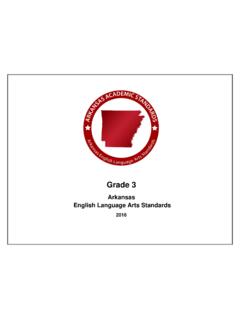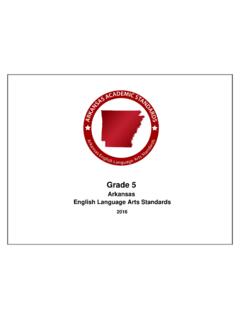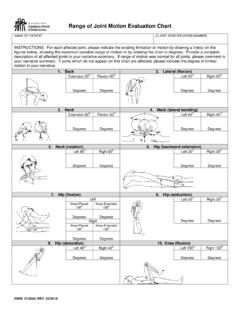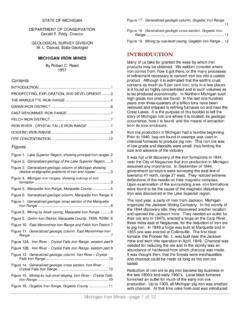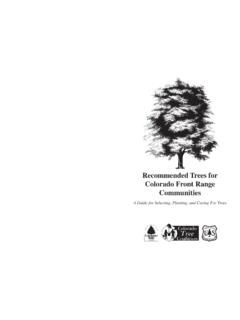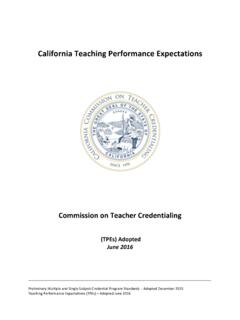Transcription of Arkansas Mathematics Standards Grades K-5
1 Arkansas Mathematics Standards Grades K-5 2016 Introduction to the Grades K-5 Arkansas Mathematics Standards When charged with the task of revising the previous Mathematics Standards , a group of qualified individuals from across the state came together to craft Standards that were specific for the schools and students of Arkansas . The result of this work, the Arkansas Mathematics Standards , is contained in this document. These Standards reflect what educators across our state know to be best for our students. These Standards retain the same structure as the previous Standards in terms of organization.
2 The Standards are organized by domains, clusters, and Standards . Domains represent the big ideas that are to be studied at each grade level and sometimes across grade bands. These big ideas support educators in determining the proper amount of focus and instructional time to be given to each of these topics. Clusters represent collections of Standards that are grouped together to help educators understand the building blocks of rich and meaningful instructional units. These units help students make connections within clusters and avoid seeing Mathematics as a discreet list of skills that they must master.
3 Standards represent the foundational building blocks of math instruction. The Standards outlined in this document work together to ensure that students are college and career ready and on track for success. There are additional similarities shared by these new Standards and the previous Standards . The main similarity is the structure of the nomenclature. The only change that was made to the naming system was intended to reflect that these Standards belong to Arkansas . However, educators may still search for open education resources by using the last part of the label, which will link to the resources for the previous Standards .
4 New Standards can be found at the end of each cluster in which a new standard was deemed necessary. Another similarity to the previous Standards is the use of the symbols (+) and (*) to distinguish certain Standards from others. The plus (+) symbol is used to designate Standards that are typically beyond the scope of an Algebra II course. However, some of the plus (+) Standards are now included in courses that are not considered to be beyond Algebra II. Standards denoted with the asterisk (*) symbol represent the modeling component of the Standards .
5 These Standards should be presented in a modeling context where students are required to engage in the modeling process that is outlined in the Standards for Mathematical Practice. The revision committee opted to include some new elements in the Arkansas Mathematics Standards that represent an attempt at greater clarity and more consistent implementation across the state. Many of the revisions are a rewording of the original Common Core State Standards . The purpose of the rewording is often to help educators better understand the areas of emphasis and focus within the existing standard.
6 Likewise, many of the Standards are separated into a bulleted list of content. This does not mean that teachers should treat this content as a checklist of items that they must teach one at a time. The content was bulleted out so that teachers can better understand all that is included in some of the broader Standards . Many of the examples that were included in the original Standards were either changed for clarity or separated from the body of the actual standard. The committee wanted 2 educators to understand that the examples included in the body of the Standards document in no way reflect all of the possible examples.
7 Likewise, these examples do not mandate curriculum or problem types. Local districts are free to select the curriculum and instructional methods they think best for their students. In some instances, notes of clarification were added. These notes were intended to clarify, for teachers, what the expectations are for the student. Likewise, these notes provide instructional guidance as well as limitations so that teachers can better understand the scope of the standard. This will help the educators in determining what is developmentally appropriate for students when they are working with certain Standards .
8 Finally, the Arkansas Mathematics Standards will become a living document. The staff of the Arkansas Department of Education hopes that this document portrays the hard work of the Arkansas educators who took part in the revision process and that it represents an improvement to the previous set of Standards . As these Standards are implemented across schools in the state, the Arkansas Department of Education welcomes further suggestions related to notes of clarification, examples, professional development needs, and future revisions of the Standards .
9 Abbreviations: Counting and Cardinality CC Operations and Algebraic Thinking OA Number and Operations in Base Ten NBT Number and Operations Fractions NF Measurement and Data MD Geometry G 3 Counting and Cardinality Know number names and the count sequence Count to 100 by ones, fives, and tens Count forward, by ones, from any given number up to 100 Read, write, and represent numerals from 0 to 20 Note: addresses the writing of numbers and using the written numerals 0-20 to describe the amount of a set of objects. Due to varied progression of fine motor and visual development, a reversal of numerals is anticipated for the majority of students.
10 While reversals should be pointed out to students, the emphasis is on the use of numerals to represent quantities rather than the correct handwriting of the actual number itself. Counting and Cardinality Count to tell the number of objects Understand the relationship between numbers and quantities; connect counting to cardinality When counting objects: Say the numbers in order, pairing each object with only one number and each number with only one object (one to one correspondence) Understand that the last number said tells the number of objects counted Understand that each successive number refers to a quantity that is one larger Note: Students should understand that the number of objects is the same regardless of their arrangement or the order in which they were counted.







